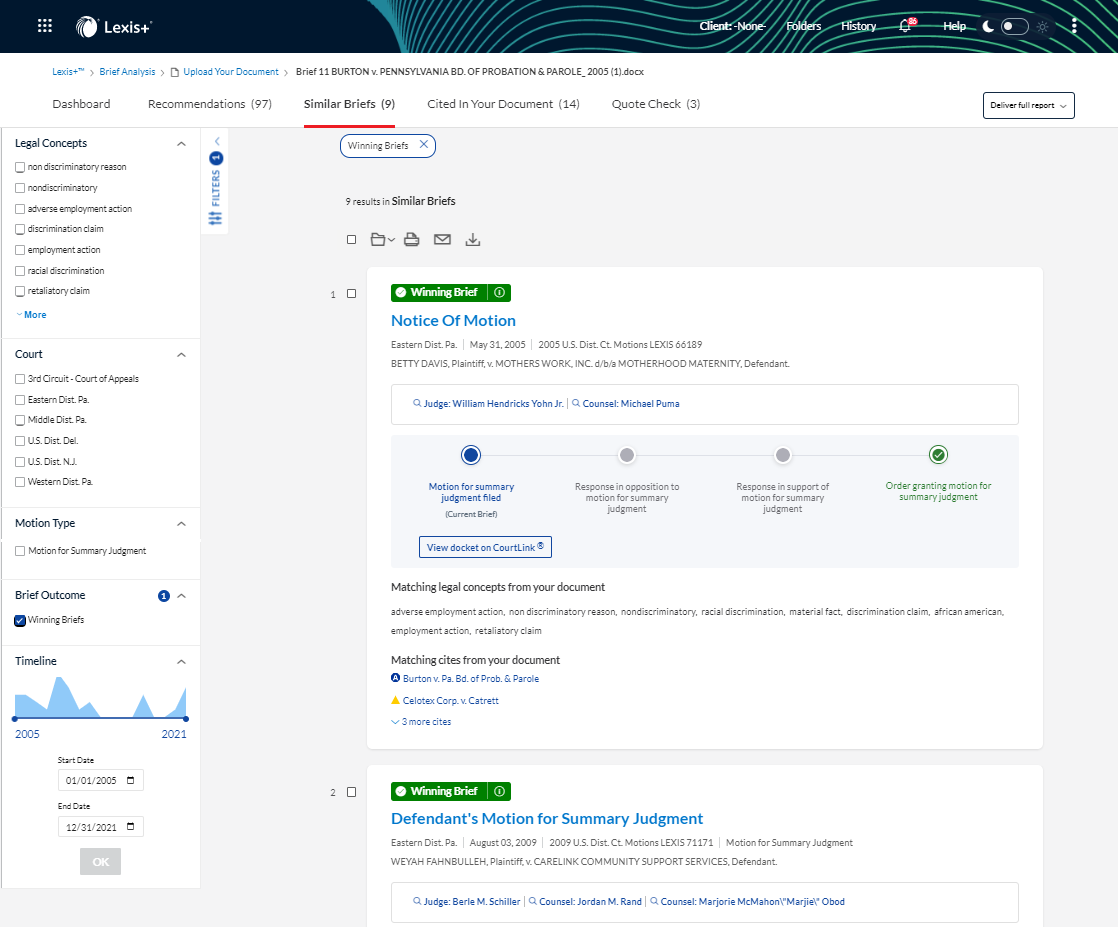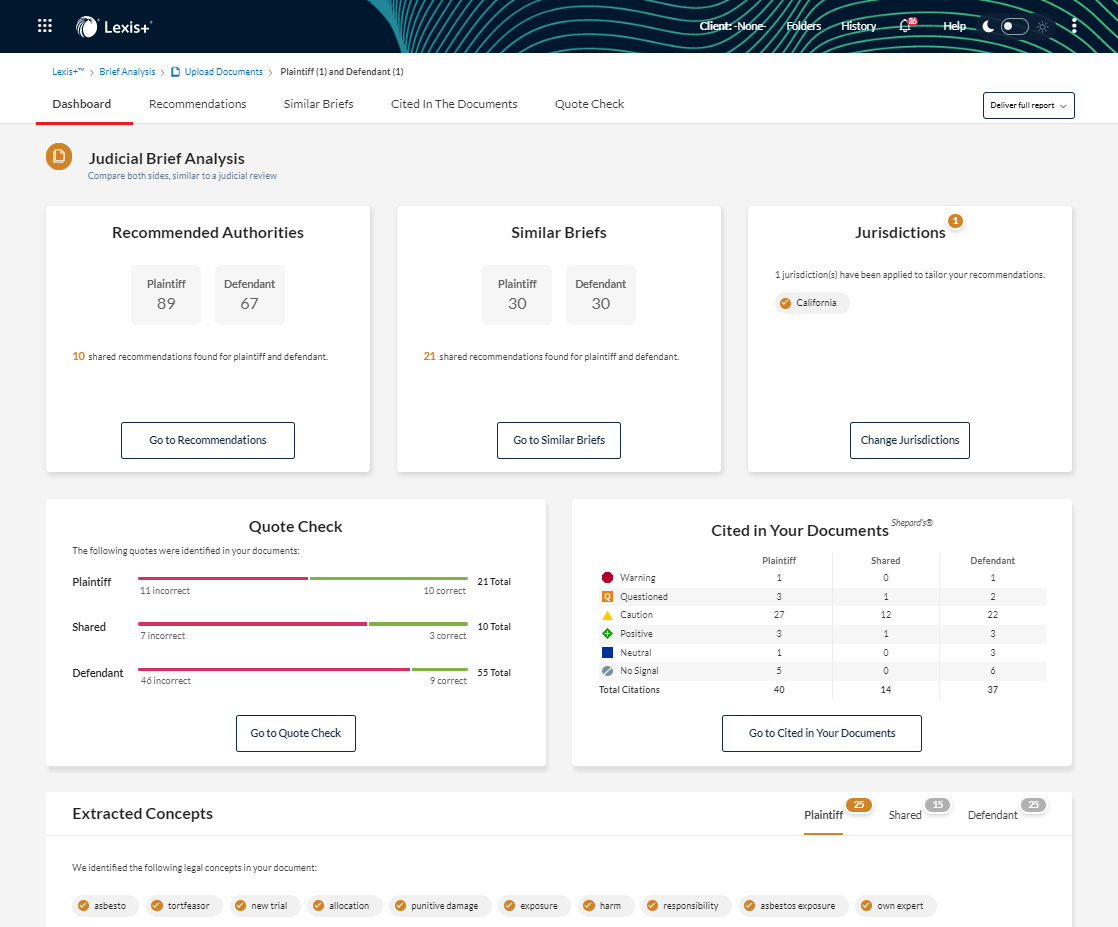Stuck Drafting A Tough Brief? This Tool Can Help.
LexisNexis Brief Analysis produces powerful, near-instant legal argumentation insights using the power of AI.

Photo courtesy of LexisNexis.
Harnessing artificial intelligence (AI) is the name of the game for the legal technology space’s most competitive players. LexisNexis’ Brief Analysis product, included as part of the Lexis+ suite, brings the latest AI-supported document analysis tech to legal professionals focused on the courtroom.
Lexis+ Brief Analysis is designed to streamline the drafting of legal briefs through a robust search of the massive Lexis+ library using AI to generate relevant, context-based research recommendations while also breaking down the content and quality of a legal brief.
Two Ways to Cover All Your Bases
Brief Analysis contains two search pathways: the standard Brief Analysis function, which utilizes a single document to generate research recommendations, and Judicial Brief Analysis, which analyzes multiple documents and not only generates research recommendations but also allows for AI-assisted comparisons between legal arguments.
A standard Brief Analysis search can also be approached in two ways: uploading a full document or pasting an isolated passage of up to 5000 characters.
In situations where a user has been tasked with drafting a new brief based on existing attorney work product, the full document search will return the most comprehensive recommendations for relevant cases and legal documents, as well as additional resources from the Lexis+ system.
The passage search option comes into play when a user is looking to, for example, tighten up a specific passage and the arguments within it. A passage search won’t necessarily return a large volume of research recommendations, but instead will direct the researcher to a smaller number of ultra-targeted results.
Comprehensive, Context-Based Search Results Presented Simply
Regardless of the specific search function used, the AI program utilized by Lexis Brief Analysis goes beyond just matching words or phrases from the uploaded document to content from the Lexis+ library to generate results.
Instead, Brief Analysis searches for relevant legal concepts — arguments, citations, etc. — by harnessing the power of AI to understand the context in which legal concepts were used in the uploaded document.
This patented concept extraction technology, created by LexisNexis, allows Brief Analysis to provide more relevant research recommendations without requiring users to craft complicated searches.
Brief Analysis then generates its results using that context, allowing the search results to be more relevant to the arguments necessary for completing the project at hand.
In other words, Brief Analysis delivers relevant recommendations even when users don’t know the right search terms to use. It can also save researchers time by analyzing an entire brief at once and returning results on multiple key arguments in that brief.
The results dashboard displays a clean, succinct overview of the research recommendations generated by Brief Analysis, including relevant cases, practical guidance, and similar briefs — all of which can give researchers an excellent picture of how other attorneys have addressed the legal questions at hand.
Lastly, users can take advantage of dashboard blocks containing information regarding procedural information, relevant jurisdictions, a full Shepard’s citation analysis, and a check on the quality and accuracy of quotes from the uploaded document.

Brief Analysis results dashboard.
Build New Drafts From Winning Arguments
Brief Analysis helps users draft a more persuasive brief by identifying more favorable case authority, specifically those that had the outcome that aligns with the user’s procedural position.
For example, if the user is representing the defendant and drafting a motion for summary judgment, the tool highlights decisions from cases with a favorable outcome on the same motion type.

Brief Analysis helps identify favorable authority.
The tool’s Winning Briefs feature also enables users to focus just on only the similar briefs results that had a winning outcome in court.

Brief Analysis identifies similar briefs with winning outcomes.
Within each research recommendation, Brief Analysis also generates a sidebar featuring a heatmap to direct researchers to key passages in the document they are currently viewing. This is where researchers can dig into the details of more targeted research recommendations applicable to specific parts of the uploaded document based on the context of that document.
Use Judicial Brief Analysis To Compare Arguments And Sources
Judicial Brief Analysis searches (i.e., searches involving two or more documents) will be most useful for users tasked with comparing and analyzing two opposing legal arguments. As the function’s name suggests, this is a powerful tool for judges and their clerks when looking to draft opinions or memoranda in response to attorney arguments.

Judicial Brief Analysis results dashboard.
Trial attorneys will also find Judicial Brief Analysis useful for quickly grasping the arguments made by opposing counsel.
Judicial Brief Analysis also allows attorneys to drill down on the specifics of how opposing counsel formed their argument. This can be especially relevant if, for example, an attorney finds that opposing counsel has filed a brief that heavily cites a case used by the attorney to form an entirely different argument.

Judicial Brief Analysis provides insights into case law arguments, citations, and quotes.
Lastly, for attorneys interested in researching a particular judge or member of the opposing counsel, Brief Analysis will provide links to pages in LexisNexis’ Context product that give background on specific legal professionals.
This background might include previous similar cases opposing counsel has worked on (and the arguments they made in those cases) or, in the case of a judge’s Context page, how the judge has ruled on similar motions in relevant past cases.







